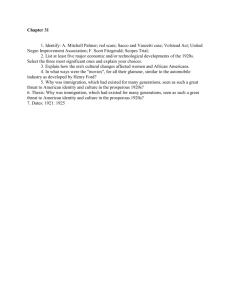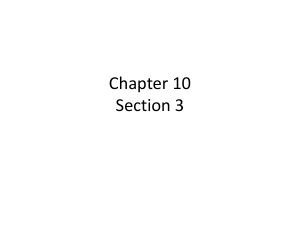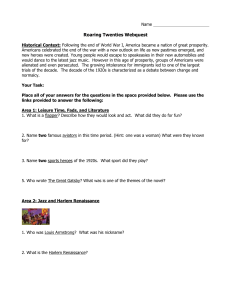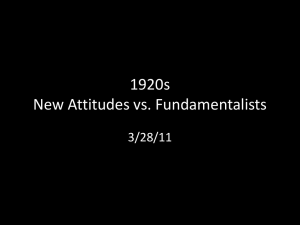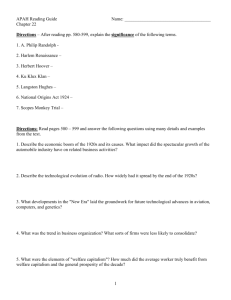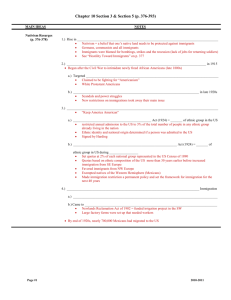A Clash of Values
advertisement
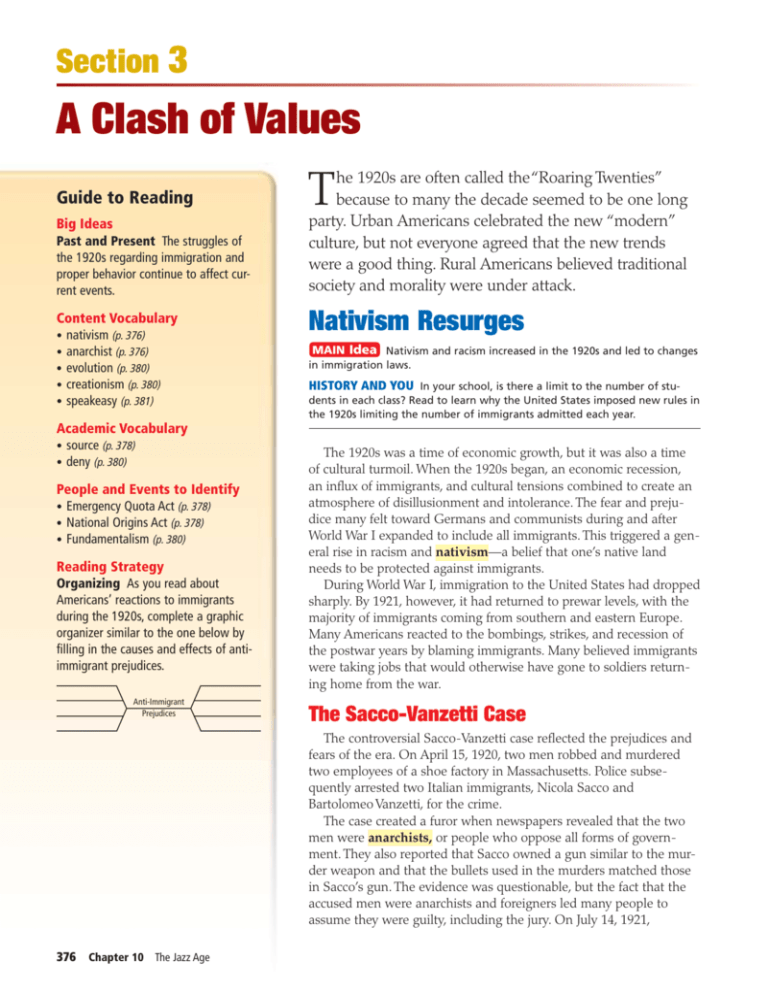
Section 3 A Clash of Values Guide to Reading Big Ideas Past and Present The struggles of the 1920s regarding immigration and proper behavior continue to affect current events. Content Vocabulary • nativism (p. 376) • anarchist (p. 376) • evolution (p. 380) • creationism (p. 380) • speakeasy (p. 381) Academic Vocabulary • source (p. 378) • deny (p. 380) People and Events to Identify • Emergency Quota Act (p. 378) • National Origins Act (p. 378) • Fundamentalism (p. 380) Reading Strategy Organizing As you read about Americans’ reactions to immigrants during the 1920s, complete a graphic organizer similar to the one below by filling in the causes and effects of antiimmigrant prejudices. Anti-Immigrant Prejudices T he 1920s are often called the “Roaring Twenties” because to many the decade seemed to be one long party. Urban Americans celebrated the new “modern” culture, but not everyone agreed that the new trends were a good thing. Rural Americans believed traditional society and morality were under attack. Nativism Resurges MAIN Idea Nativism and racism increased in the 1920s and led to changes in immigration laws. HISTORY AND YOU In your school, is there a limit to the number of stu- dents in each class? Read to learn why the United States imposed new rules in the 1920s limiting the number of immigrants admitted each year. The 1920s was a time of economic growth, but it was also a time of cultural turmoil. When the 1920s began, an economic recession, an influx of immigrants, and cultural tensions combined to create an atmosphere of disillusionment and intolerance. The fear and prejudice many felt toward Germans and communists during and after World War I expanded to include all immigrants. This triggered a general rise in racism and nativism—a belief that one’s native land needs to be protected against immigrants. During World War I, immigration to the United States had dropped sharply. By 1921, however, it had returned to prewar levels, with the majority of immigrants coming from southern and eastern Europe. Many Americans reacted to the bombings, strikes, and recession of the postwar years by blaming immigrants. Many believed immigrants were taking jobs that would otherwise have gone to soldiers returning home from the war. The Sacco-Vanzetti Case The controversial Sacco-Vanzetti case reflected the prejudices and fears of the era. On April 15, 1920, two men robbed and murdered two employees of a shoe factory in Massachusetts. Police subsequently arrested two Italian immigrants, Nicola Sacco and Bartolomeo Vanzetti, for the crime. The case created a furor when newspapers revealed that the two men were anarchists, or people who oppose all forms of government. They also reported that Sacco owned a gun similar to the murder weapon and that the bullets used in the murders matched those in Sacco’s gun. The evidence was questionable, but the fact that the accused men were anarchists and foreigners led many people to assume they were guilty, including the jury. On July 14, 1921, 376 Chapter 10 The Jazz Age Hostility Toward Immigrants In the 1920s, many Americans believed that immigrants from southern and eastern Europe would not assimilate into American culture. These concerns led to the rise of a new Ku Klux Klan and efforts in Congress to pass legislation that would keep “undesirable” immigrants out. Immigrants (millions) European Immigration, 1900–1924 Men, women, and children participate in a Klan march in Cincinnati, Ohio, in 1925 (left). Membership in the KKK soared in the early 1920s because of its opposition to immigrants. Not everyone agreed with the Klan, however; the cartoon above mocks a proposal to impose a literacy test on immigrants. 5 Analyzing VISUALS 4 1. Making Inferences What does the presence and membership of children in the Klan suggest to others? 2. Analyzing Visuals What is the “wall” made of in the cartoon? 3. Making Connections From which two regions did the majority of immigrants come? Why were so many people from these regions willing to leave their homelands and come to the United States? 3 2 1 0 United Kingdom Germany Eastern Europe Southern Europe Source: Historical Statistics of the United States. Sacco and Vanzetti were found guilty and sentenced to death. After six years of appeals, Sacco and Vanzetti were executed on August 23, 1927. Return of the Ku Klux Klan At the forefront of the movement to restrict immigration was the Ku Klux Klan, or KKK. The old KKK had flourished in the South after the Civil War and used threats and violence to intimidate newly freed African Americans. The new Klan had other targets as well: Catholics, Jews, immigrants, and other groups said to be “un-American.” In the 1920s, the Klan claimed it was fighting for “Americanism.” William J. Simmons founded the new Ku Klux Klan in Georgia, in 1915. A former preacher, Simmons pledged to preserve America’s white, Protestant civilization. The Klan attracted few members until 1920, when Simmons began using professional promoters to sell Klan memberships. By 1924 membership had reached nearly 4 million as it spread beyond the South into Northern cities. The Klan began to decline in the late 1920s, however, largely as a result of scandals and power struggles between its leaders. Membership shrank, and politicians backed by the Klan were voted out of office. In addition, new restrictions on immigration deprived the Klan of one of its major issues. Read “Sacco and Vanzetti Must Die” by John Dos Passos on pages R74–R75 of the American Literature Library. Chapter 10 The Jazz Age 377 Controlling Immigration American immigration policies changed in response to the postwar recession and nativist pleas to “Keep America American.” Even some business leaders, who had favored immigration as a source of cheap labor, now saw the new immigrants as radicals. In 1921 President Harding signed the Emergency Quota Act. The act restricted annual admission to the United States to only 3 percent of the total number of people in any ethnic group already living in the nation. Ethnic identity and national origin thus determined admission to the United States. In 1924 the National Origins Act made immigration restriction a permanent policy. The law set quotas at 2 percent of each national group represented in the U.S. Census of 1890. Thus, immigration quotas were based on the ethnic composition of the country more than 30 years earlier—before the heavy wave of immigration from southern and eastern Europe. The new quotas deliberately favored immigrants from northwestern Europe. Although subsequent legislation made some changes in immigration laws, the National Origins Act set the framework for immigration for the next four decades. Hispanic Immigration Explaining How was the Ku Klux Klan of the 1920s different from the earlier Klan? 378 Chapter 10 The Jazz Age MAIN Idea Supporters of the new morality in the 1920s clashed with those who supported more traditional values. HISTORY AND YOU How do you think older generations view your generation? Read about the changes in morality during the 1920s. Many groups that wanted to restrict immigration also wanted to preserve what they considered to be traditional values. They feared that a “new morality” was taking over the nation. Challenging traditional ways of behaving, the new morality glorified youth and personal freedom and changed American society—particularly the status of women. Women in the 1920s Having won the right to vote in 1920, many women sought to break free of the traditional roles and behaviors that were expected of them. Attitudes toward marriage—popularized by magazines and other media—changed considerably. As the loving and emotional aspects of marriage grew in importance, the Changing Roles for Women As women achieved greater independence, access to higher education, and professional opportunities in the 1920s, they adopted new clothing styles that expressed their identities. ▲ While workers and unions rejoiced at the reduction in competition with European immigrants for jobs, employers desperately needed laborers for agriculture, mining, and railroad work. Mexican immigrants were able to fill this need because the National Origins Act of 1924 exempted natives of the Western Hemisphere from the quota system. Large numbers of Mexican immigrants had already begun moving to the United States after the passage of the Newlands Reclamation Act of 1902. The act funded irrigation projects in the Southwest and led to the creation of large factory farms that needed thousands of farmworkers. As the demand for cheap farm labor steadily increased, Mexican immigrants crossed the border in record numbers. By the end of the 1920s, nearly 700,000 had migrated to the United States. A Clash of Cultures Many young women adopted the flapper style in the 1920s. They stopped wearing corsets, bobbed their hair, and wore short skirts, high heels, and rounded hats with almost no brim. The style expressed the sense of freedom many women felt in the 1920s. changes, even though she was not typical of most women. The flapper smoked cigarettes, drank prohibited liquor, and wore makeup and sleeveless dresses with short skirts. Women who attended college in the 1920s often found support for their emerging sense of independence. Women’s colleges, in particular, encouraged their students to pursue careers and to challenge traditional ideas about women’s role in society. Many professional women made major contributions in science, medicine, law, and literature in the 1920s. In medicine, Florence Sabin’s research led to a dramatic drop in death rates from tuberculosis while Edith Wharton, Willa Cather, and Edna Ferber each won a Pulitzer Prize in fiction for their novels. Public health nurse Margaret Sanger believed that families could improve their standard of living by limiting the number of children they had. She founded the American Birth Control League in 1921 to promote knowledge about birth control. This organization became Planned Parenthood in the 1940s. During the 1920s and 1930s, the use of birth control increased dramatically, particularly among middle-class couples. Educational opportunities for women increased in the 1920s, and with education came new professional opportunities. A 1922 magazine cover depicts a college girl. Below is Judge Florence E. Allen, in her judge’s chambers in Ohio. In 1920 she became the first woman elected to a state supreme court. Women Earning College Degrees Degrees Earned ▲ ideas of romance, pleasure, and friendship became linked to successful marriages. The popularizing of Sigmund Freud’s psychological theories also changed people’s ideas about relationships. Freudian psychology emphasized human sexuality and his theories (often oversimplified) became acceptable subjects of public conversation. The automobile played a role in encouraging the new morality. Cars allowed young people to escape the careful watch of their parents. Instead of socializing at home with the family, many youths could now use cars to “go out” with their friends. Women in the workforce began to define the new morality. Many working-class women took jobs because they or their families needed the wages but for some young, single women, work was a way to break away from parental authority and establish financial independence. Earning money also allowed women to participate in the consumer culture. Fashion, too, changed during the 1920s, particularly for women, who “bobbed,” or shortened, their hair, wore flesh-colored silk stockings, and copied the glamorous look of movie stars. The flapper personified these 50,000 40,000 30,000 20,000 10,000 1920 1922 1924 1926 1928 1930 Year Source: Historical Statistics of the United States. Analyzing VISUALS 1. Speculating Clothing is often used to create a specific impression or to convey social status. What image or attitude does each of these women convey with her attire? 2. Analyzing Visuals What happened to the number of women earning college degrees during the 1920s? Chapter 10 The Jazz Age 379 (r)Columbus Dispatch/Ohio Historical Society The War Against Alcohol Prohibition supporters argued that it reduced violence, illness, and poverty. Critics argued that it increased violence because gangs fought to control the sale of illegal alcohol, and that it led to illness because many people drank unsafe “moonshine.” Number of Murders* Murder Rate, 1920–1940 10.0 9.0 8.0 7.0 6.0 1920 ▲ Supporters of Prohibition portrayed the sale of alcohol as a danger to mothers and children. 1925 1930 1935 1940 Year *per 100,000 residents Source: Historical Statistics of the United States. ▲ Analyzing VISUALS Prohibition led to the creation of a special federal bureau charged with stopping the sale of illegal alcohol. In this photo, a federal agent cracks open barrels of illegal rum in San Francisco in 1927. Fundamentalism While many Americans embraced the new morality, others feared that the country was losing its traditional values. They viewed the consumer culture, relaxed ethics, and changing roles of women as evidence of the nation’s moral decline. Many of these people, especially in rural towns, responded by joining a religious movement known as Fundamentalism, a name derived from a series of Christian religious pamphlets titled “The Fundamentals.” Fundamentalist Beliefs Fundamentalists believed that the Bible was literally true and without error. They rejected the idea that human beings derived their moral behavior from society and nature, not God. In particular, they rejected Charles Darwin’s theory of evolution, which said that human beings had developed from lower forms of life over the course of millions of years. Instead, they believed in creationism—the belief that God created the world as described in the Bible. 380 Chapter 10 The Jazz Age 1. Theorizing How might opponents of Prohibition use the murder rate in the 1920s and 1930s to support their argument? Can you think of other reasons the murder rate might have fallen in the 1930s? 2. Analyzing Visuals How does the poster use emotional appeal to strengthen its argument? Two popular preachers, Billy Sunday and Aimee Semple McPherson, stirred supporters by preaching in very nontraditional ways. Sunday, a former professional baseball player, drew huge crowds with his showmanship and rapid-fire sermons. McPherson conducted her revivals and faith healings in Los Angeles in a flamboyant theatrical style, using stage sets and costumes that expressed the themes of her highly emotional sermons. The Scopes Trial In 1925 Tennessee outlawed any teaching that denied “the story of the Divine Creation of man as taught in the Bible,” or taught that “man descended from a lower order of animals.” The American Civil Liberties Union (ACLU) advertised for a teacher willing to be arrested for teaching evolution. John T. Scopes, a biology teacher in Dayton, Tennessee, volunteered. He taught evolution and was arrested. The trial took place in the summer of 1925. William Jennings Bryan, a three-time presidential candidate, was the prosecutor who represented the creationists. Clarence Darrow, one of the country’s most celebrated trial lawyers, defended Scopes. After eight days of trial, Scopes was found guilty and fined $100, although the conviction was later overturned on a technicality. The trial had been broadcast over the radio, and Darrow’s blistering crossexamination of Bryan hurt the Fundamentalist cause. Increasingly, Fundamentalists felt isolated and their commitment to political activism declined. Prohibition The movement to ban alcohol grew stronger in the early 1900s. People supported the prohibition of alcohol sales for many reasons. Some opposed alcohol consumption for religious reasons; others thought prohibition would reduce unemployment, domestic violence, and poverty. Prohibition supporters achieved their goal when the Eighteenth Amendment went into effect in January 1920. Congress passed the Volstead Act, making the U.S. Treasury Department responsible for enforcing Prohibition. Treasury agents had enforced federal tax laws for many years, but police powers—a government’s power to control people and property in the interest of public safety, health, welfare, and morals—had generally been reserved for state governments. The Eighteenth Amendment granted federal and state governments the power to enforce Prohibition, marking a dramatic increase in federal police powers. The Treasury Department struggled to enforce Prohibition. During the 1920s, treasury agents made more than 540,000 arrests, but Americans persisted in blatantly ignoring the law. People flocked to secret bars called speakeasies, where they could purchase alcohol. In New York City alone, an estimated 32,000 speakeasies sold liquor illegally. Liquor also was readily available in rural areas, where bootlegging—the illegal production and distribution of liquor—was common. Organized crime thrived on the illegal trade in alcohol. Huge profits could be made smuggling liquor from Canada and the Caribbean. Crime became big business, and some gangsters had enough money to corrupt local politicians. Al Capone, one of the most successful and violent gangsters of the era, had many police officers, judges, and other officials on his payroll. Capone dominated organized crime in Chicago. Finally, Eliot Ness, the leader of a special Treasury Department task force, brought Capone to justice. More than 70 federal agents were killed while enforcing Prohibition in the 1920s. The battle to repeal Prohibition began almost as soon as the Eighteenth Amendment was ratified. The Twenty-first Amendment, ratified in 1933, repealed the Eighteenth Amendment and ended Prohibition. Prohibition had reduced alcohol consumption, but it had not improved society in the ways its supporters had hoped. Identifying What political, social, and economic contributions did women make to American society in the 1920s? Section 3 REVIEW Vocabulary 1. Explain the significance of: nativism, anarchist, Emergency Quota Act, National Origins Act, Fundamentalism, evolution, creationism, speakeasy. Main Ideas 2. Identifying What two factors influenced the limits on immigration? 3. Summarizing What issues caused clashes between traditional and new moralities? Critical Thinking 4. Big Ideas Why did many Americans oppose immigration after World War I? What connections can you make with immigration policies today? 5. Categorizing Use a graphic organizer similar to the one below to list the provisions of the immigration acts passed in the 1920s. Act Provisions 6. Analyzing Visuals Look at the chart on page 377 showing European immigration. How would these figures have affected someone who was a nativist? Why? Writing About History 7. Persuasive Writing Imagine it is the 1920s. Write a letter to your senator persuading him or her either to continue supporting Prohibition or to work for its repeal. )JTUPSZ 0/-*/& Study Central™ To review this section, go to glencoe.com and click on Study Central. 381


